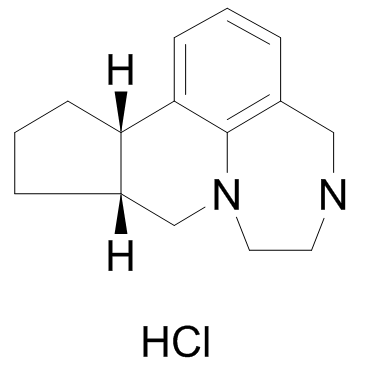| Description |
Vabicaserin hydrochloride is a 5-hydroxytryptamine 2C (5-HT2C) receptor-selective agonist with an EC50 of 8 nM.
|
| Related Catalog |
|
| Target |
5-HT2C Receptor:8 nM (EC50)
|
| In Vitro |
Vabicaserin displaces 125I-(2,5-dimethoxy)phenylisopropylamine binding from human 5-HT2C receptor sites in Chinese hamster ovary cell membranes with a Ki value of 3 nM and is >50-fold selective over a number of serotonergic, noradrenergic, and dopaminergic receptors. Binding affinity determined for the human 5-HT2B receptor subtype using [3H]5HT is 14 nM. Vabicaserin is a potent and full agonist (EC50, 8 nM; Emax, 100%) in stimulating 5-HT2C receptor-coupled calcium mobilization and exhibits 5-HT2A receptor antagonism and 5-HT2B antagonist or partial agonist activity in transfected cells, depending on the level of receptor expression. Vabicaserin exhibits lower affinity at the 5-HT2C antagonist binding site (22 nM) labeled with [3H]mesulergine. Additional binding studies indicate that Vabicaserin possesses affinity for the 5-HT2B and 5-HT1A receptors with Ki values of 14 and 112 nM, respectively[1].
|
| In Vivo |
After a single oral dose of [14C]Vabicaserin at 50, 5, and 15 mg/kg, unchanged drug represents less than 19, 20, and 35% of total plasma radioactivity at all the time points examined in mice, rats, and dogs, respectively. The carbamoyl glucuronide (CG) represents approximately 7 to 36% of plasma radioactivity in mice and 2 to 28% of plasma radioactivity in dogs but is not detected in rat plasma after the single [14C]Vabicaserin dose. However, the CG is observed in rat plasma after multiple-dose administration of Vabicaserin at higher doses, and the CG is approximately 20 times less than Vabicaserin based on steady-state AUC0-24 values. The estimated plasma AUC0-24 ratios of CG to the parent drug are 1.5 and 1.7 in mice and dogs after the single [14C]Vabicaserin dose, respectively. The plasma AUC0-24 ratios for the CG to Vabicaserin at steady state with doses used for safety assessment are less for mice (0.2-0.6) and slightly higher for dogs (1.8-4.0) compared with the single dose values. The CG is detected in dog urine in similar amounts to the parent drug, although it is not detected in mouse or rat urine after the single [14C]Vabicaserin dose. Radioactivity in a 0- to 24-h bile collection from rats receiving a 5 mg/kg [14C]Vabicaserin dose accounts for 19 and 24% of the administered dose in males and females, respectively. Although the CG is not detected in urine or feces of rats after a single oral administration, it represents an average of up to 30% of biliary radioactivity in male rats and 15% in female rats. In monkeys after a single oral 25-mg/kg dose of Vabicaserin, the plasma concentrations of the CG exceeded those of Vabicaserin at all the time points (2-24 h) postdose, although the amount of CG relative to Vabicaserin decreased by 24 h postdose, with ratios of 17.5 at 2 h and 1.7 at 24 h. The CG to Vabicaserin AUC0-24 ratio of 12:1 indicates that the CG is a major metabolite in monkeys[2].
|
| Animal Admin |
Mice and Rats[2] For metabolism studies in mice, rats, and dogs, radiolabeled doses are used. Male and female CD-1 mice and Sprague-Dawley rats are used. The dose vehicle for mice and rats contained 2% (w/w) Tween 80 and 0.5% methylcellulose in water. Nonfasted male and female mice weighing from 27.8 to 33.8 g at the time of dosing are given a single 50-mg/kg (∼300 μCi/kg) dose of Vabicaserin at a volume of 20 mL/kg via intragastric gavage. Mice are kept in metabolic cages in groups of five. Nonfasted male rats weighing from 318 to 345 g and female rats weighing from 227 to 255 g at the time of dosing are given a single 5-mg/kg (∼300 μCi/kg) dose of Vabicaserin at a volume of 2.5 mL/kg via intragastric gavage. Four bile duct-cannulated male rats weighing from 387 to 411 g and four bile duct-cannulated female rats weighing from 291 to 325 g at the time of dosing are nonfasted and are given a single 5-mg/kg (323 μCi/kg) dose of Vabicaserin at a volume of 5.0 mL/kg via intragastric gavage. Rats are kept individually in metabolism cages[2]. Dogs[2] Four male beagle dogs, weighing from 7.6 to 9.8 kg at the time of dosing, are from an in-house colony. Approximately 11 mg of [14C]Vabicaserin hydrochloride and 940 mg of nonlabeled Vabicaserin hydrochloride are dissolved in methanol and then evaporated under a nitrogen stream to dryness. Capsules (number 2) are filled with accurate amounts (126.7-138.1 mg) of the mixed drug substance according to animal weights to give a dosage of 15 mg/kg (39 μCi/kg). The filled gelatin capsules are then enteric-coated manually. Each dog is given one enteric-coated capsule containing [14C]Vabicaserin as the hydrochloride salt. Animals are fed 2 h before dosing and are housed individually in metabolic cages[2]. Monkey[2] Four male cynomolgus monkeys, weighing from 5.4 to 9.6 kg at the time of dosing, are from an in-house colony. Nonfasted monkeys are given a single 25-mg/kg dose of nonradiolabeled Vabicaserin at a volume of 2 mL/kg via intragastric gavage. The vehicle is the same as used in mice and rats. Animals are housed individually in metabolic cages[2].
|
| References |
[1]. Dunlop J, et al. Characterization of Vabicaserin (SCA-136), a selective 5-hydroxytryptamine 2C receptor agonist. J Pharmacol Exp Ther. 2011 Jun;337(3):673-80. [2]. Tong Z, et al. Species differences in the formation of Vabicaserin carbamoyl glucuronide. Drug Metab Dispos. 2010 Apr;38(4):581-90.
|
